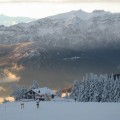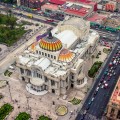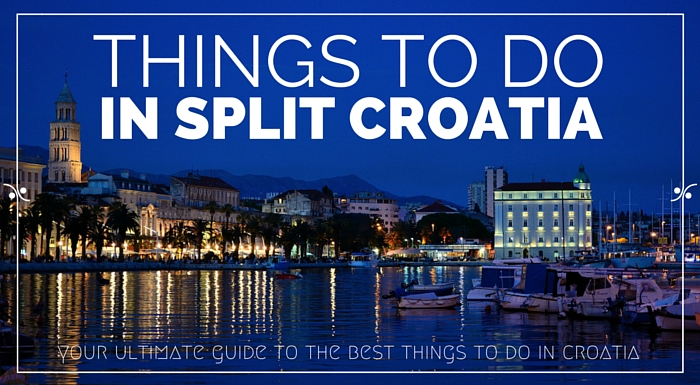
Split is a typical Mediterranean town, vibrant, charming and fun. As the largest Dalmatian town, Split also offers to its visitors loads of things to do. Stroll along Split’s seafront promenade, visit museums and art galleries, hike Marjan hill or just chill out at the beach.
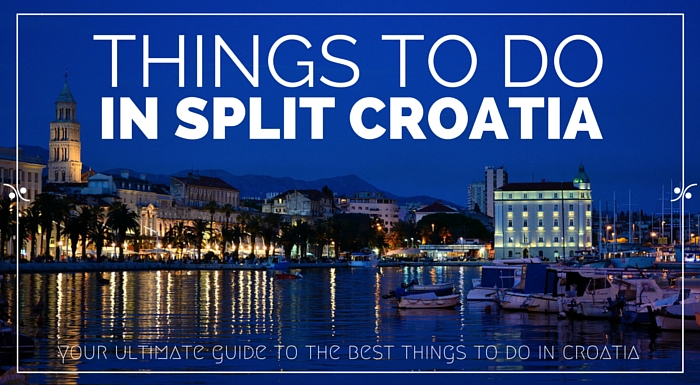
Massive list of top things to do in Split
Explore Split old town
Visiting old town is one of the first things to do in Split. The oldest part of Split is set in the roman palace dating back to the early 4th century. Roman emperor Diocletian has built the palace, supposedly as his retirement home. Originally, the palace measured 170 by 200 m, with 20 m high outer walls. While the palace is one enormous historical site, it is also the center of Split’s everyday life.
Therefore, every visit to Split, short or long, inevitably focuses on wandering Split’s narrow, cobbled streets, discovering hidden alleyways, enjoying beautiful architecture and popular Split landmarks.
The Diocletian Palace is one of seven UNESCO World Heritage Sites in Croatia.
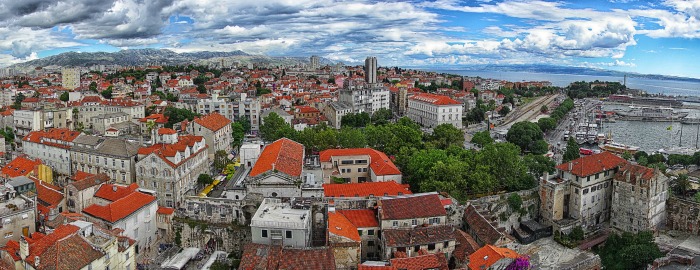
Landmarks with the palace include:
Peristyle, an open-air pavilion, best seen at nighttime, brings you right back to Roman times.
Split Cathedral offers great views over the town from the top of its bell tower.
There are four town gates, each on one side of the palace: The Golden, Silver, Bronze and Iron Gate.
Just out of the Golden gate, you’ll also see Gregory of Nin (Grgur Ninski) statue, work of renowned Croatian sculptor Ivan Mestrovic. Rub Gregory’s tow for the plenitude of good luck.
You don’t need to head to Egypt to see the original Egyptian sphinxes. Find the two of them in Split, on Peristyle, near Jupiter Temple that today serves as a baptistery.
It can take you one full day to explore Split numerous churches, palaces and museums.
“Let me pass” street is said to be the narrowest street in the world (not sure about this, but it is pretty narrow).
Piazza, or People’s Square, became town’s central point, in the 14th century. The square features few interesting landmarks and buildings, and it’s always alive with people.
Vocni Trg, or Fruit Square, owes its name to the fruit market that once took place here daily. Today, it boasts few cafes, shops, Venetian Octagonal Towerfrom the 15th centuries; the 17th century baroque Palace Milesi; and a statue of Marko Marulic, a 15th century poet, and a father of Croatian literature. The statue is a work of famed Croatian sculptor – Ivan Mestrovic.
We’ve covered only a fragment of landmarks, and historical buildings to find in old town Split. Don’t limit yourself to these few. Just explore this magnificent town, and discover it for yourself.
Discover Split’s neighborhoods
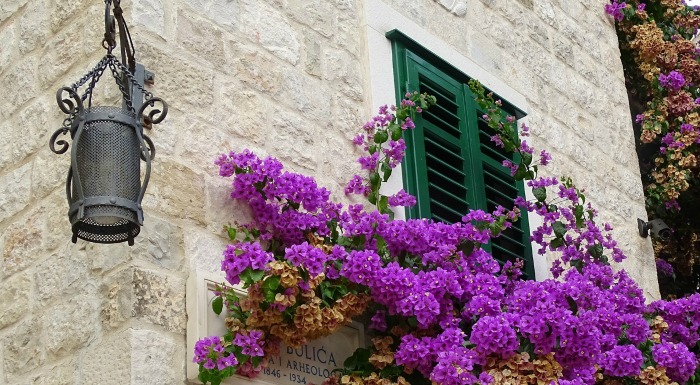
On your quest for things to do in Split, don’t dismiss discovering other Split’s neighborhoods. Because, out of the palace walls, Split has other neighborhoods worth discovering. Four oldest neighborhoods are Varos, Dobri, Lucac and Manus.
These neighborhoods developed in the 16th century around the town walls. Peasants and fishermen used to inhabit these neighborhoods.
They are all charming. They resemble a typical Dalmatian village, with their narrow, winding streets, small stone houses, taverns, inside courts and green window’s shutters.
A small fishing and leisure boat port, Matejuska is located at the west end of Riva, Split’s waterfront promenade. It’s a lovely little port, and a place where locals, especially youth, like to hang around.
Bacvice is Split’s neighborhood of beach, picigin {local water sport, where small ball is thrown between players in the shallow water}, sport and cafes.
Spinut, a residential area of Split, is a home to Split stadium – Poljud. Hajduk, a soccer club from Split, is the oldest soccer club in Croatia and integral part of identity of any Dalmatian. Visit the stadium during your stay in Split. Or, even better, go and see the soccer game and cheer the local club.
Visit Marjan Hill
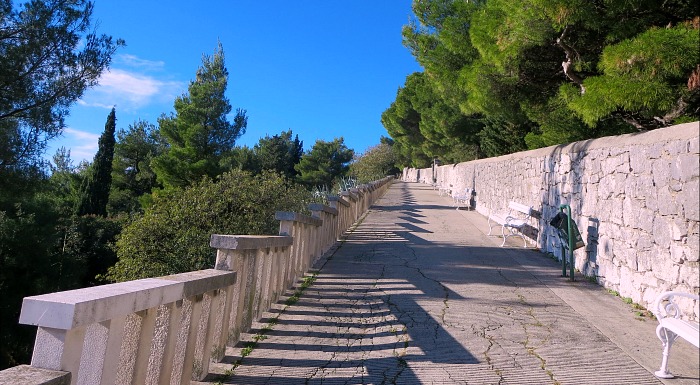
A 178 m high hill, set at the small peninsula, northwest of the old town, Marjan Hill is locals’ favorite recreational spot close to the city center.
The hill offers numerous footpaths and jogging trails, and it has always been a popular place for walking, jogging, rock-climbing, and mountain-biking (more about some of these activities below).
Up, at the summit, there is a café bar Vidilica, perched atop the hill, where you can chill out, and enjoy a view over the town and the sea.
Explore churches on Marjan Hill
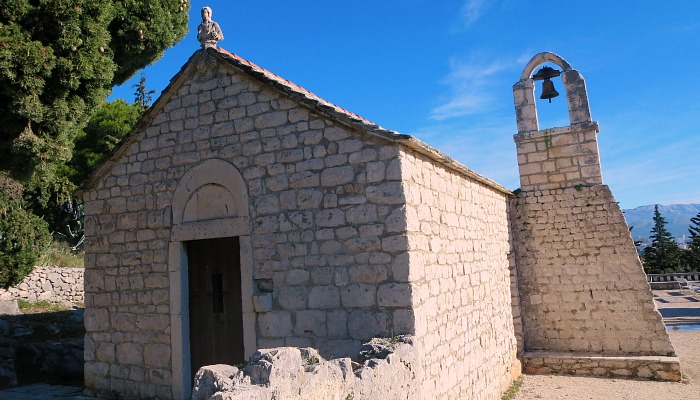
Hey, when you are already hiking Marjan Hill, don’t miss to explore numerous small churches, and chapels scattered throughout the area.
St. Jere Church was built in the 15th century. We like this church because of a nearby hermitage site, carved into the hill rocks.
Located on the southeast slopes of Marjan, a church of St. Nicolas the Travelerwas built in the early 13th century.
A church of Our Lady of Good Council was built in 1513, within the Capogrosso Castle. It contains woodcuts by Croatian sculptor Ivan Mestrovic, showing the life of Christ.
A church of Our Lady of Seven Sorrows is located in the area of Kasjuni. It was built in the mid -14th century. It contains a relief from the 17th century, believed to be a work of Juraj Dalmatinac, a great sculptor and architect from the time of Venetian Republic.
Other churches on the Marjan Hill include Our Lady of Bethlehem, St. George, St. Benedict, Our Lady of Spinut, St. Magdalene of the Poor, etc.
Visit Split Museums
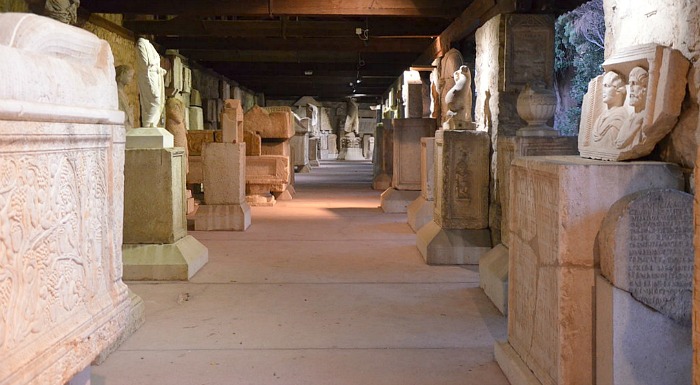
Since the entire old town of Split is like a large open-air museum, one might feel less tempted to visit actual museums. Museums in Split aren’t of the size, or importance of famed European museums, like Florence’s Uffizi, or Naples’ Archaeological Museum. However, if you are in a town for a couple of days or more, visit some of museums of Split.
Split Town Museum, located in a 15th century Gothic palace, is small and you’ll get through it quickly. It gives a good overview of town’s history and its development through the times.
Archaeological Museum of Split is the oldest museum in Croatia and it displays artifacts from Greek, Roman, early-Christian, medieval and prehistoric times. It is located 15 min walk from the old town.
Ethnographic Museum of Split displays pottery, traditional clothing, furniture, jewelry and other artifacts from the life of Split inhabitants throughout the history. It is located in the old town and the entrance fee is very affordable (less than 2€).
Split Live Museum was first open in 2015. It is located in the old town, not far from the Golden Gate. It showcases the everyday life of romans, back in times when they inhabited these areas. The actors are dressed in ancient costumes, and they give interesting performance, each one not lasting more than 15 minutes.
Other museums include Museum of Croatian archaeological monuments andMaritime museum.
Stop by Split Art Galleries
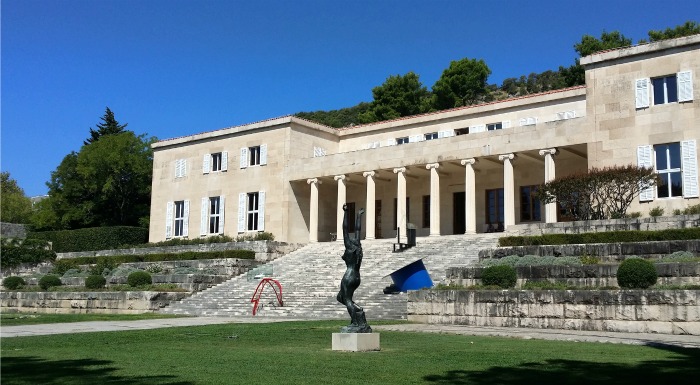
Ivan Mestrovic, the most renowned 20th century Croatian sculptor of international reputation, lived and worked in Split in his younger age. He spent many summers in his holiday home in Split. He designed the house himself, and it was built between 1931 and 1939. In 1952, Mestrovic donated his property, along with over 100 of his artwork to the state. Today, it houses Ivan Mestrovic Gallery.
The Mestrovic gallery has many works of the sculptor on permanent display. His works are displayed through two floors of the building, as well as in the front garden. Besides sculptures, the house itself is an interesting to see.
Jaksic Gallery is a family-run gallery that displays artwork of various Jaksic family members. They open their first gallery in Donji Humac on the island of Brac, back in 2008, and in 2015 they followed with this exhibition room in Split. You’ll find on display here Lovro Jaksic sculptures, Dina Jaksic paintings, or Ida Stipcic Jaksic jewelry.
Studio Naranca is a family-run three story art shop, and gallery, located near the Golden Gate, at the northern side of the old town. The interior is lovely, resembling an interior of a boat. Here you can purchase original souvenirs, like paintings, handmade jewelry, various arts and crafts, painted grocery bags, t-shirts, and graphics.
Jaman Gallery displays work of local painter – Danijel Jaman. His paintings are flashy, colorful, and imaginative. The gallery also offers various prints, postcards, and phone cases.
Hit the beach
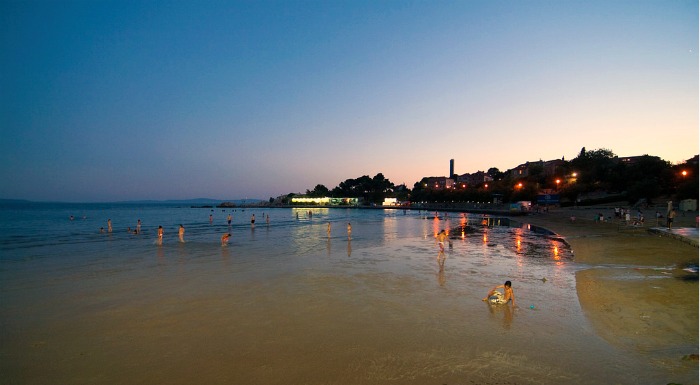
Don’t forget that Split is actually located by the sea. So, on a hot summer day, take some downtime to chill out on one of town’s popular beaches.
If you like crowds, water sports and stylish cafes, head to Bacvice beach. Bacvice is the most popular local beach, the only sandy beach in the town, and it’s closest to the old town. From Bacvice, further southeast, you’ll find other popular Split beaches like Ovcice, Firule, Trstenik and Znjan.
At the foot of the Marjan Hill, you’ll find various beaches, less crowded than beaches to the southeast of the old town.
The most popular ones are Jezinac, Bene and Kasjuni beach. Bene beach still has lots of trees and shadow and the water is clean. Kasjuni has been recently arranged, with a lounge bar offering sun beds, and umbrellas to rent.
Stroll along Split seafront promenade (Riva)
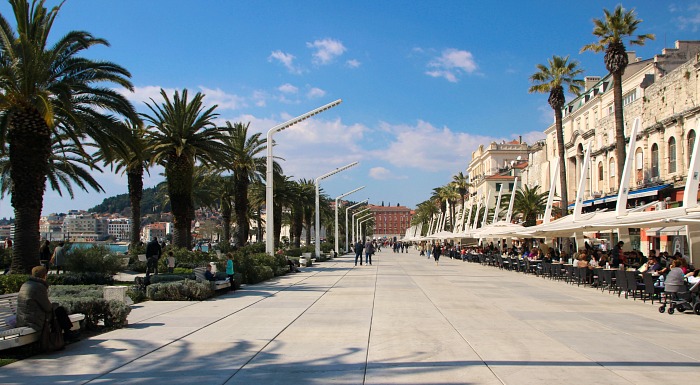
Split’s waterfront, Riva, is the heart of the town, and the pride of every person from Split.
People of Split demonstrated in 2007, after Riva’s renovation, how sensible they are to their waterfront . Riva’s new, shiny look enraged locals so much that they protested for months demanding the old patina to be brought back. I think today everybody would agree that the new look is simply great.
Seafront promenade is lined with cafes, bars, eateries and souvenir shops. On the east side there is a green market, and on the west side there is a Republic square, church of St. Francis and a nice fountain.
Enjoy morning or evening stroll, have a drink in one of many bars, and feel the vibe of this magnificent city. People-watch is the local sport here.
Bargain at Split green and fish market
Split’s legendary green market, called Pazar, is the soul of the city. Wander between the stalls, enjoy the smells and colors of the fresh produce. Bargain with the old ladies.
You can spend over an hour just walking around. If you are looking for a bargain, your best shot is to come after the midday, when the market is about to close down for a day.
Fish market is as exciting to me, as Split’s green market. But surprisingly, they aren’t adjacent one to another. Quite opposite! They are laid on opposite sides of the old town: green market to the east, and fish market to the west.
We love examining the daily catch, and get particularly excited by small, blue fish, like anchovies, and sardines. This kind of fish is typical for the Adriatic, and was a staple of Dalmatian cuisine for centuries.
Wine & Dine in Split
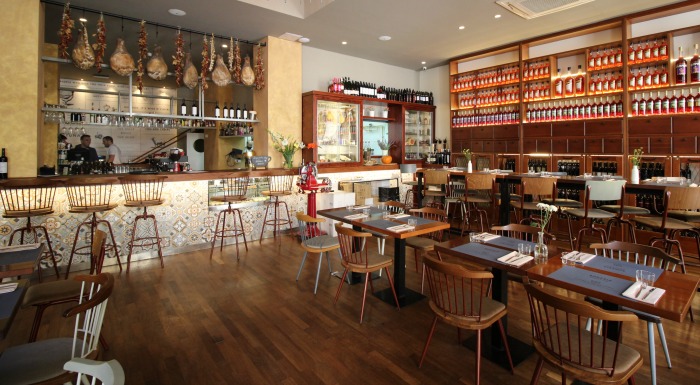
Split has many charming restaurants, wine and olive oil bars. After your evening stroll at the seafront promenade, go for an aperitif and a plate of small bites at Paradox, Zinfandel or Uje Oil Bar.
Proceed with an enjoyable Dalmatian-style meal, finest seafood or juiciest steaks, in one of Split restaurants.
After the dinner, barhop in and around the Palace. Grab a pillow at Luxor, sit on the stairs, and relax with a glass of wine while listening to the live music.
Sea Kayaking
Sea kayaking is a great way to experience a different Split, and to get active.
Many local agencies offer this tour. Usually, you can choose between two sea kayaking tours: morning, and sunset tour. Both tours take you paddling around the Marjan Hill with organized swimming, snorkeling, and cliff jumping stops.
Each tour lasts four hours, and includes a 3 miles of paddling. Morning tour starts at 9.00 am, and afternoon tour starts at 5 pm. Meeting point is at the bus station no. 12 in front of the St. Francis Church, 30 minutes before the start. Tours are offered daily from April through September.
Poljud Stadium Tour
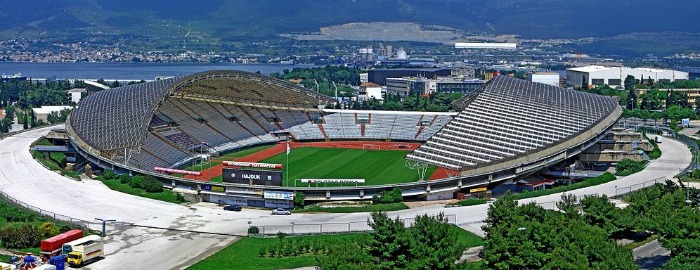
If you have a chance to drive along Dalmatian coast, in every village you’ll notice a mural dedicated to Hajduk, a soccer club from Split. Hajduk is a love and pride of every Dalmatian.
So if you really want to understand this devotion, you should take a tour of Poljud stadium. On this tour you can learn about the history of Hajduk, the oldest soccer club in Croatia, founded in 1911.
Hajduk’s stadium, Poljudska ljepotica, or simply Poljud, is located in Spinut neighborhood. It was built in 1979 for the Mediterranean games, and has been a home field of Hajduk ever since.
This tour is available daily. Tour costs 35 kn (approx. 5 euro) per adult, and 20 kn (approx. 3 euro) per child 6 to 12 years of age.
Play a game of picigin with locals
Picigin is local ball game, super-popular all over Dalmatia, but particularly in Split, and even more precisely, particularly at the Bacvice beach.
This ball game is apparently older than soccer, and it’s been playing in Split since 1908.
The game is played with an old, stripped off tennis ball, in a shallow water. The idea is to have ball in the air for as long as possible. There aren’t winners in picigin. Normally it’s played by five players, each standing 6 to 7 meters one from another. The main idea is to throw ball to other payers in a way to make them do attractive jumps, and acrobatic moves. Players can only hit the ball with their palms.
Picigin is an integral part of Split identity. And if you visit Bacvice beach (anytime of the year), you should see locals playing this fun game.
If you have a chance, join in with locals to try your luck at picigin.
Rock climbing
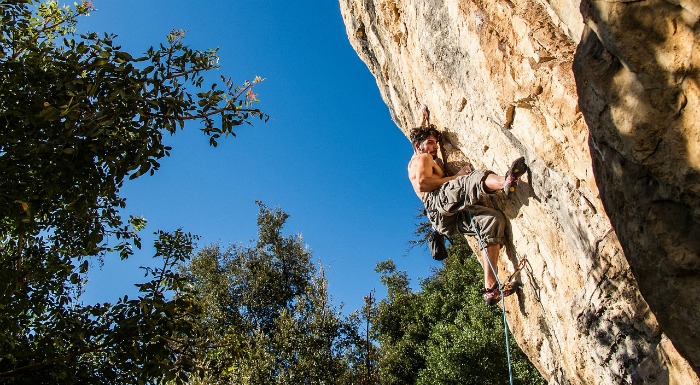
Marjan crag was one of the first sites in Dalmatia where organized sport climbing took place back in 1986. It’s not very common to find such a great climbing site right in the heart of the city. Split alpinists trained at Marjan for various climbing expeditions around the world.
The sport climbing area is known as Santine Stine, 40 m high south-facing cliffs, located at the westernmost part of Marjan, just above Kasjuni beach.
The area counts 77 mostly vertical routes, with difficulty level from 4c to 8a. The most interesting routes are in the range of 5c to 7a.
The area around Marjan Hill also offers few sites to take on deep water solo. This can be a good alternative to classical rock climbing, on hot summer days, when more serious and demanding climbing routes can be out of reach due to high air temperatures. Two popular sites for deep water solo are Kasjuni Beach, and Sustipan.
Roomescape Experience
On our last visit to Split our friends booked us on a Roomescape experience in Split. You’ve perhaps already heard about this fun game, where you get locked in and need to find your way out following clues around you.
Roomescape offers two scenarios: Prison puts you behind the bars, and you need to escape from the jail; in other one you have to escape the “Cold War Bunker”.
We played the Prison. But, we can’t really reveal much, because that would ruin the game. The game was fun, and we manage to escape just on time.
You have an hour to find your way out. Otherwise, the moderator gives you the clues, helps you solve the mystery, and gets you out.
Number of players: 2-5
Price per game: 320 kn (64-160 kn per person)
Sky-diving
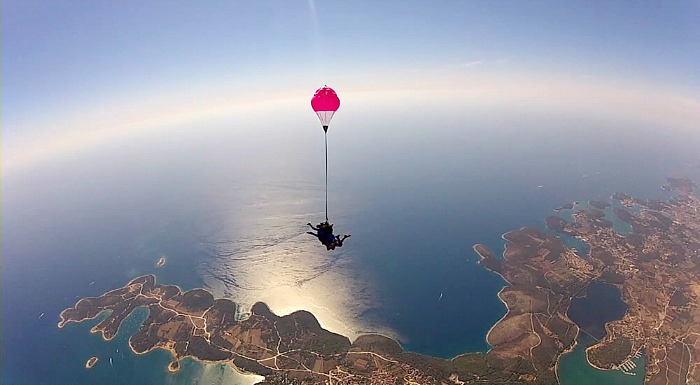
Sky-diving is not for faint-hearted. But for those who dare to do it, it’s one of the most rewarding experiences to have. I know this first-hand. And I was (seriously!) scared to death. And wishing never to have boarded that plane in the first place. But once down at the ground, I was happy to have done it. It’s off my bucket list, and I won’t repeat it. For me, once was enough. Anyways …
If you look for some adrenaline rush, and to take Split, and beautiful Adriatic, from yet another perspective, skydive might be just a right answer for you.
Your plane takes off from small sport airport in Sinj, 40 km east from Split. The tour includes a panoramic flight, and a tandem jump. Freefall lasts for about 30 seconds, and a parachute flight lasts a bit less than 10 minutes.
Island hopping
You know that only few years ago, Split, as far as tourists were concerned, was only a place where they all came just to catch a ferry boat to nearby islands. Back in times, Split wasn’t touristy town. It was an industrial town, and a getaway port to more popular tourist destinations, like island of Brac, or Hvar.
Today, Split is one of the most visited places in Croatia, where tourists actually base themselves, and then visit islands for a day or two. Things change sometimes in unexpected ways.
If you stay in Split for a couple of days, you should get out to the sea, and visit some of the islands. The interesting islands to visit for a day include Brac, Hvar, Solta, Drenik Veli, and even Vis (although Vis demands at least two days).
You can visit these islands by ferry boat, on your own. It’s perhaps the cheapest option, unless you travel by car (car fares for ferry come at hefty price!). But it’s also the most limiting option if you have a limited time.
Sail away for a day (or night)
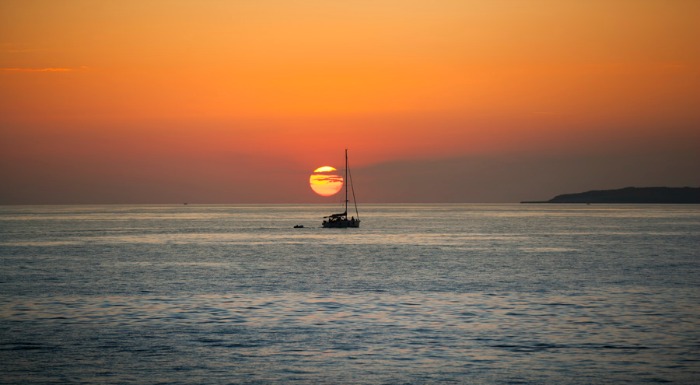
Island hopping is fun, but although it’s relaxing, you still have a destination in mind that you want to reach. How about a simple day of sailing without anywhere to really go, no real place in mind where you need to arrive. Just pure relaxation at the sea. Out of hustle and bustle of Split, or any tourists-filled sites.
Now, that’s the way to unwind! And if you have a spare time while staying in Split, a Scottish couple organizes day and sunset sails on board their 42 foot sailing boat Nera for up to six persons.
The trip includes drinks, and a freshly prepared lunch. Day sailing tour lasts 7 hours (from 10 am to 5 pm). The cost is 160 euro per person.
Sunset sailing tour is shorter. It includes small bites, and drinks. Dinner is optional. Price is 75 euros per person.
Visit Roman ruins in Solin
Solin is a small town 6 km away from Split. In roman times it was an administrative center of a roman province of Dalmatia. Its ancient name was Salona. If you like history, visit to Solin is one of the great things to do in Split.
There are roman ruins, including basilica, amphitheater, pillars, many sarcophagus, etc. The site is not as impressive as some other roman sites. However, a visit to Solin makes a nice day out from Split.
Klis fortress
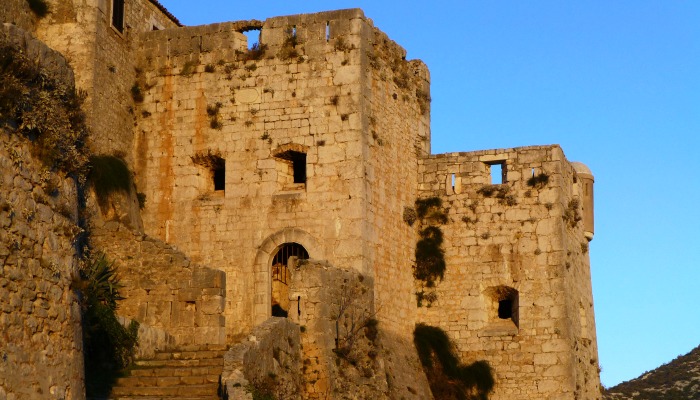
Less than 15 km from Split, on a mountain pass between Kozjak and Mosor Mountains, lies medieval Klis Fortress.
The fortress had a very important defensive role throughout the history. And it’s a remarkable example of fortification architecture in Dalmatia.
The site is pretty large, and it rises on a cliff. Besides ruins, a small museum, and a church, you can enjoy spectacular views over Split, Adriatic, and the islands.
The site was a filming set for Meereen scenes in HBO Games of Thrones series. You can visit the fortress as a part of the Game of Thrones Tour.
Otherwise, you can visit a fortress on a self-guided tour, by car, or by a local bus. The number 22 bus leaves from HNK station in Split, and the fare is 13 KN.
Entrance fee to the fortress is 40 KN. There is a fair amount of climbing, but nothing really demanding.
Learn to cook like a Dalmatian
If I want to get a quick idea of a place I’m visiting, I always do two sup ermarket. And I try to taste an authentic local dish.
In my opinion, supermarkets reveal a lot about culture, and habits. How clean are they? What kind of items, especially food, do they have on display? How expensive are groceries? I am guilty of drawing some conclusions about the country on this simple visit.
And local dishes can tell me even more about people than any guide book. I take them as a sneak peek into habits, and a lifestyle of people who created them.
My wife is Dalmatian, and I can tell you that Dalmatian food is really tasty, but yet unpretentious, and clean. Dalmatian have a typical Mediterranean diet, filled with fish, especially blue fish, and veggies, particularly green veggies, like Swiss chard, kale, spinach, and alike. Then, they have succulent stews that normally cook for hours, like yummy pasticada, a baby beef stew, or brujet, a spicy fish stew.
I get hungry just thinking of it.
You can use your time in Split to learn about, and try your hand at some of typical Dalmatian dishes.
We know about two agencies offering cooking classes in and around Split: Cooking Class with Tatjana in Trogir by Culinary Croatia, and Art of Wine Cooking Class with Jaksa Bedalov.
Visit Trogir and the Blue Lagoon
Less than 30 km from Split lies Trogir, a lovely medieval town, and UNESCO World Heritage site since 1997.
First founded by Greeks, in the 3rd century BC, many different nations ruled the town, like Romans, Venetians, Hapsburg Monarchy, French, Italians, before Croatia gained independence in 1991.
Trogir is relatively small, and you can see all major landmarks within an hour. Some of the landmarks include the 15th century Kamerlango Fortress, interesting Palaces like Garagnin-Fanfogna Palace and Cipiko Palace; St. Lawrence Church is especially nice, as well as former Duke’s Palace (serving as the city hall today), clock tower, and loggia.
The town is built of stone with narrow cobbled streets, charming architecture, and secret courtyards. Visiting Trogir is high on our list of things to do in Split.
If you are visiting Trogir during summer, consider hopping to the island of Drvenik Veli for the best swimming and snorkeling in the area.
Drvenik Veli is a small island, just over an hour boat ride from Trogir. Very few people live on the island, and there aren’t any large tourist infrastructure. The most popular spot on the island is Uvala Krknjasi, popularly called Blue Lagoon due to its turquoise waters.
Spend a day at the Krka Waterfalls
Located less than an hour drive from Split, Krka Waterfalls is one of Croatian seven national parks, and a wonderful site to visit when in Split.
While Krka Waterfalls might be less known, and thus less popular than Plitvice Lakes, they are as beautiful, and you can actually swim in these emerald waters(not allowed at Plitvice Lakes!).
The entire park has numerous hiking trails, along lakes, waterfalls, and caves. The best way to visit the park is to take a boat from Skradin. But if you are short with time, you can simply drive to the park, and start exploring.
The main sights include, Roski slap, a 22 m high waterfall, Skradinski buk, the longest travertine barrier of Krka River, Visovac, a tiny island featuring Franciscan Monastery, and the 15th century Church of Our Lady of Visovac. Other sights include numerous caves, remains of medieval fortresses, and beautifully restored watermills.
Tips & Info
It’s easy to visit the park on your own from Split if you have a car (or you rent one for a day). If you don’t have a car, you can go with a tour company.
If you would like to see all the main sights, go early in the morning, and spend entire day at the park. Bring your swimming suit, and jump in the lake, just below Skradinski buk. If you are short with time, limit your visit to one or two sights. Skradinski buk is only 10 minute walk from the parking.
Admission | Nov-March: 30 kn adult, 20 kn child (7-18) | Apr-June, Sept-Oct: 110 kn adult, 80 kn child (7-18) | July, Aug: 180 kn adult, 110 kn child (7-18);
Children below 7 are free of charge. Ticket includes all sites, return boat ticket from Skradin to Skradinski buk, and a return bus ticket from entrance Lozovac to Skradinski buk. Boat and buses don’t run from Nov to March.
Go white-water rafting
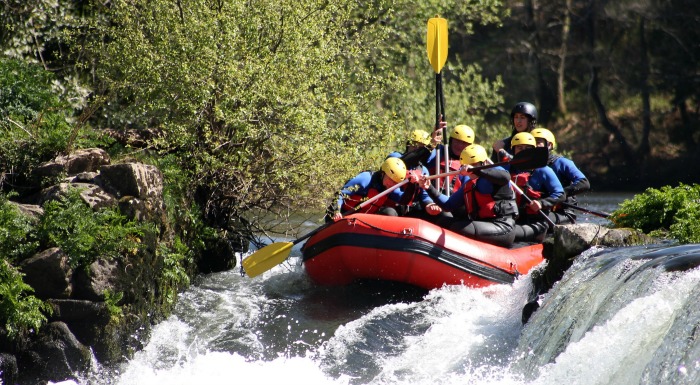
Rafting on Cetina River is one of the most popular outdoor adventures in Croatia, and one of our favorite things to do in Split.
And there is no excuses not to try it.
First, Omis, a small coastal town where white-water rafting awaits you, is a gem forall kinds of adventures (rafting, canoeing, canyoning, zip-lining …), and it’s only 20 km south of Split.
Second, haven’t you always been dreaming about putting that wet suit on?! Everybody simply look … well … ridiculously funny!
Third, this is one of those places where, as an adult, you can scream … along with your adult companions in the raft.
All jokes aside, rafting on the Cetina River is a must. It doesn’t take any previous experience to do the course. The course is 4-hours long, but it’s not all paddling. It also includes few short stops along the way for swimming (only for those who don’t fret cold waters), cliff jumping, and resting.
Many agencies offer rafting on the river, with a transfer from and to Split. Prices go from 30 euros (without a transfer), to 45 euros (with transfer), and up to 60 euros with lunch.
Hike Mosor Mountain
Once you visit Dalmatia, you’ll quickly learn that not only a wonderful Adriatic Sea, but high mountains stretching all along the coast, make this region really, really special.
I am an avid walker. Two-hour walk a day is part of my daily routine. I wouldn’t skip it for nothing. But there is one thing I notice immediately when I arrive to my in-laws place in Dalmatia. My daily step count might be the same, but my floor count goes up to the skies. Dalmatia is mountainous, and I love it even more for that.
Exploring nearby mountains of Mosor is one of great things to do in Split. Mosor Mountain is part of Dinaric Alps, rugged mountains stretching from Slovenia to the northwest all the way down to Albania to the southeast.
You can access Mosor from Klis, or Zrnovnica and Gornje Sitno. You can reach all three villages by public bus from Split: no. 22 for Klis, and no. 28 for Zrnovnica and Gornje Sitno. You can do the same by car.
Trails are well marked (red and white sign), and on weekends you’ll meet many locals. Whether you decide to do a full round trip of the ridge, or just a part of it, don’t miss on Umberto Girometta mountain hut. Plan for a comforting (and rewarding) rustic, homemade lunch here.
Jeep Safari
We’ve just gave you an idea of hiking Mosor Mountain. But, maybe you aren’t keen on hiking unknown mountains on your own. Or, you aren’t in shape for hiking at all. Still, you too would like to experience Split’s hinterland, and fresh mountainous air. Don’t worry!
Get on-board a jeep, for an exciting ride on Kozjak Mountain.
Similar to Mosor, Kozjak Mountain is also part of Dinaric Alps. The mountain can be reached from a village of Kastela (to get to Kastela you can take bus no. 37).
Kozjak is not as high as Mosor, its highest peak, Veli Vrj, is on 779 m. There arefour mountain huts on Kozjak (if you decide to explore on your own). The most popular one is Malacka hut to the west part of the mountain.
Ha! But back to jeep safari. The tour takes you to the top of the Kozjak Mountain for wonderful views over the sea, Split, and the nearby islands. You’ll also have a chance to experience off-road drive along the mountain, as well as to visit sometypical villages and to eat homemade lunch. Highly recommended!
Zip-line over Cetina Canyon
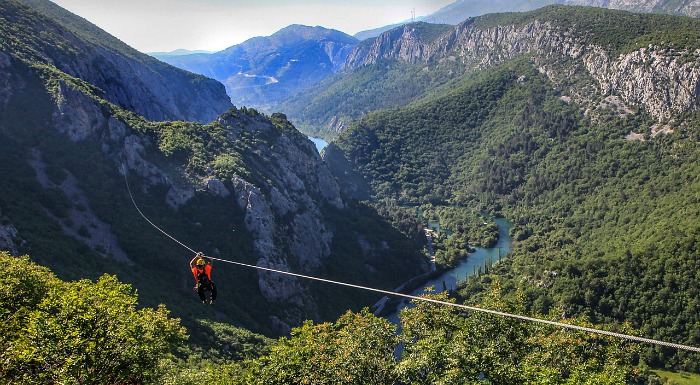
Note for all: For those who haven’t done it yet – zip-lining is awesome! For those who have done it already – you know what I’m talking about!
When in Split, don’t miss on zip-lining across Cetina River Canyon. The site is a short 20 km ride from Split (in summer it takes 45 minute by car because traffic between Split and Omis is heavy).
Once there you’ll have a choice of eight lines, each of different length, height, and speed. At the fastest wire you can catch a speed of up to 65 km per hour. All that while hanging 150 m above the ground and admiring fantastic views over the canyon.
Do a tour on your own if you have a car to reach the site. But make sure you book at least two days in advance. You can do so through Zip-line Croatiawebsite. The price is 400 kn per person.
Canyoning
If you search for even more adrenaline rush than rafting, zip-lining, or sky-diving can get you, why not try canyoning while in Split?
A short drive from Split, you can choose between two sites to try your hand at canyoning: Badnjevica, and Cetina.
Badnjevica is more popular among locals than tourists. It’s a lovely canyon of river Suvaja, in Imotski region. Canyoning in Badnjevica includes hiking through forest and shallow water, abseiling down a 17 m long waterfall, swimming, and cliff jumping.
Cetina canyoning is one of the best outdoor activities in vicinity of Split. The tour starts in a village of Zadvarje where you get a safety brief. Afterwards guides take you to the starting point where the tour starts with repelling down a cliff into the water. The tour combines some hiking, rope lowering, cliff jumping, swimming, and for most of the time – floating down the river pushed by streams, and rapids.
Bear in mind that the tour takes around 5 hours (including a transfer from and to Split). Bring good pair of hiking shoes, the rest of equipment is provided (even shoes are provided, but we prefer wearing our shoes). The temperature of water is anywhere between 15 °C and 17 °C, depending on season.
Lots of agencies offer this day trip, like Adventure Dalmatia, and Split Adventure. The prices go from 50 euro per person for a standard canyoning on Cetina, 75 euro per person for extreme canyoning on Cetina, and 105 euro per person for Badnjevica canyoning (transfers included).
Cycling
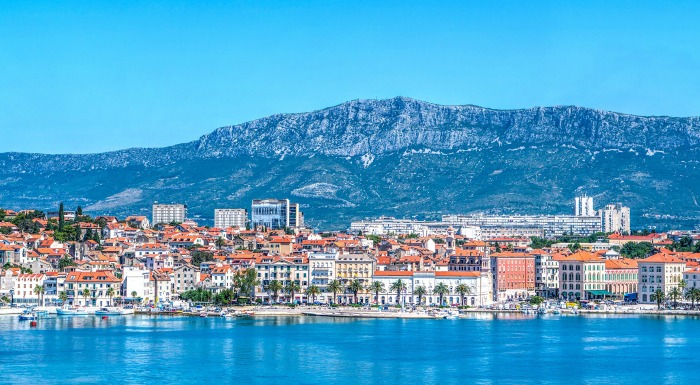
Split isn’t really cycling-friendly town. The old town is cramped. And even if bicycles are allowed within the old town (not sure!), believe me, it’s a hustle to walk it, not to mention cycling.
The rest of the town has a heavy car traffic, and no bike trails.
However, there are sites within the town that are still good for cycling.
Marjan Hill first come to mind. You can rent a bike, and then explore the hill by bicycle. If you ride along the coast, just below Marjan Hill, you’ll pass Mestrovic Gallery, and Kastelet, where you can stop to enjoy the works of this famed Croatian sculptor. Continue along the main road until beach Kasjuni. Here you can stop for a swim or a refreshment. After the beach, you’ll reach a car-free zone. The gravel road will take you up the hill all the way to Telegrin, the highest peak of Marjan. You can also head back down to the town earlier, without reaching the top.
Beaches to the southeast of the old town are also a good choice for in-town cycling. You can cycle from the old town, all the way to Znjan Beach, and back. This route is mostly flat, but the cycling is mostly on the main car road.
Many companies rent bikes, including electric ones. City bikes go from 3 euro for two-hour rent, to 12 euro for a daily rent. Mountain bikes go from 6 euro for a two-hour rent, to 16 euro for a daily rental. Electric bikes cost around 40 euros a day.
Pub crawl
If you are looking for a good night out in Split, then you should consider joining a pub crawl tour. This is the easiest way to meet fellow travelers, and locals, all while getting a taste of Split’s nightlife.
You know the drill: at least 100 minutes of power hour with all you can drink formula in a hidden bar in Split, followed by pub crawl where your group gets discounted prices on all drinks, and ending a night in a local club where you dance through wee hours.
There are a couple of agencies offering pub crawl tour, like Tower Pub Crawl, Ziggy Star Pub Crawl, and Original Europe Tours.
Prices range from 15 to 20 euro per person.
Try local craft beers
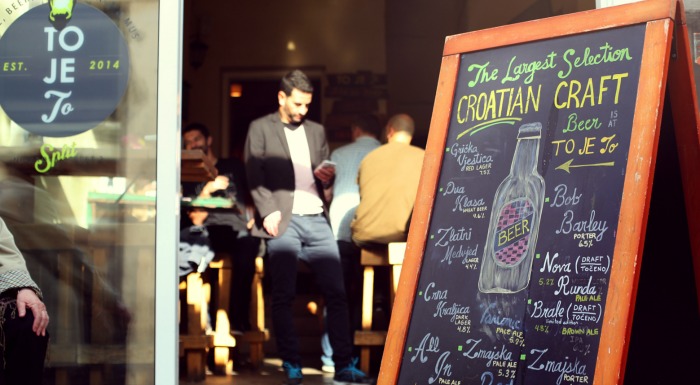
Just a couple of years ago, you couldn’t find a decent local beer in Croatia. Sure, there were guys home brewing their beer, but it wasn’t available to general public. But things changed a lot recently, and now Croatia offers very exciting and dynamic craft beer scene.
Two local microbreweries are LAB, and Fjaka Brewery. LAB offers two labels: Barba ALE, and Barba Englez (English Pale Ale). Fjaka, on the other hand, offers only one label – New World Order IPA.
Our favorite Croatian craft beers are Prvo Visko Pivo Saison, Vuneotovo’s Black IPA – Aljaski Mrgud, and Nova Runda APA.
Best bars in Split to discover Croatian craft beers are To Je To, and Leopold’s Delicatessen Bar. They offer 4 to 5 tap beers, and a good selection of bottled beers.
Canoe safari
You must have figured out by now that Cetina River is THE place for all who look for outdoor adventures close to Split.
Canoe safari is basically rafting in calm waters, and in summer, waters on Cetina are normally calm. This means that canoe safari is perhaps more appropriate than rafting at that time of the year.
The tour lasts a bit less than four hours, but worry not, you don’t spend all time paddling. The course is just over ten kilometers, and it includes few swimmingstops along the way.
River tubing
When you feel lazy but still want to experience some outdoors, river tubing comes as an ideal adventure. It is fun. It requires minimum fitness level (Yay for that!). And if you are anything like me, you prefer sports that include lying down.
River tubing happens at calm part of river Cetina, along 3 km long course. There are few rapids to push you down the stream, but for the rest you’ll be floating down the river, relaxed in your tube, admiring lovely scenery.
Explore countryside with ATV
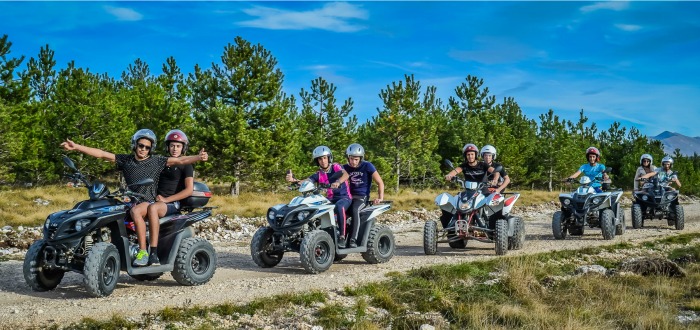
ATV for those who don’t know stands for all terrain vehicle, and growing up in Canada, I had lots of experience riding these beasts. However, Vera was little familiar with quads.
When she insisted that we rent one in Bol, and went off-road driving along the dusty coastal road to Ciccio tavern, I knew she’ll regret it the minute we touch the gravel path. She didn’t want to listen to me. To make a long story short, three years since then, she’s still not ready for another quad ride.
Quad rides are bumpy, and quads can seem unstable at times. But that’s what makes riding them fun.
Quad adventure in Split takes you to the mountains in the back of Split. The ride gives you opportunity to experience different Croatia, far from the main touristy sites.
You’ll drive through half-abandoned villages, stop at heights of mountains forspectacular views, and end your tour with a lovely meal before heading back to Split.
Try your hand at SUP
We’ve tried stand up paddle in our little village, a couple of years ago. A German tourist tuned in a village with a board, and a paddle. That was new to us.
The way he was paddling around made us think that SUP was super simple. But when we tried it, it was another story. We kept falling into water way too many times.
Anyways, since that first time, we became true fans of stand up paddle, and would recommend it to anybody.
With a right instructor, you actually get to learn paddling techniques quickly. Once you do that, I promise you’ll enjoy this activity fully.
SUP tours from Split include: in-town tour around Marjan Hill, and out-of-town tours in Brela, and in Blue Lake near Imotski. If you have a time, we recommend a Blue Lake Tour.
First, paddling on a lake is easier than in the sea, for a simple reason that waters are normally calmer.
Second, this tour will give you a chance to discover the country side, and stumble upon villages you normally wouldn’t see.
Third, this tour normally includes a traditional Dalmatian lunch at the end of the paddling.
If you don’t have enough time to spend paddling, than opt for a tour in Split. It’s the most convenient time-wise, and the cheapest of all.


